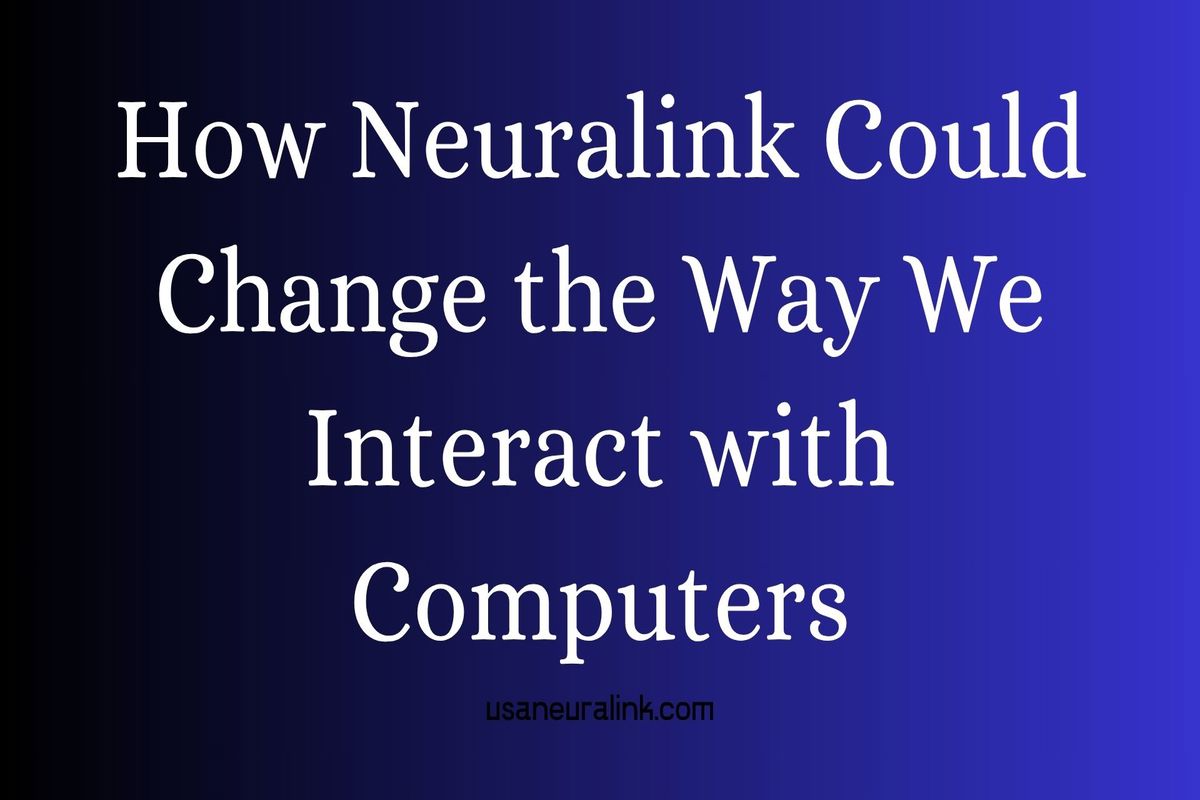How Neuralink Could Change the Way We Interact with Computers
Introduction to Neuralink and Brain-Computer Interfaces
Imagine controlling your smartphone, typing an email, or playing a video game using only your thoughts. This futuristic vision is becoming a reality with Neuralink, a neurotechnology company founded by Elon Musk in 2016. Neuralink is developing brain-computer interface (BCI) technology, specifically the N1 implant, which aims to connect the human brain directly to computers. This groundbreaking innovation could revolutionize how we interact with technology, treat neurological disorders, and even enhance human cognition. In this blog post, we’ll explore how Neuralink works, its potential applications, and the profound impact it could have on our daily lives.
What Is Neuralink?
Neuralink is a company focused on creating implantable brain-computer interfaces that translate neural signals into digital commands. The N1 implant, a coin-sized device, is surgically embedded in the skull using a precision robot called R1. It features 1,024 ultra-thin electrodes distributed across 64 threads, thinner than a human hair, which connect to neurons in the brain to record and stimulate electrical activity. These signals are processed by a custom chip and transmitted wirelessly via Bluetooth to external devices like smartphones or computers.
The technology builds on decades of BCI research but stands out due to its high channel count, wireless capabilities, and minimally invasive design. Unlike earlier BCIs that used bulky external electrodes, Neuralink’s implant is cosmetically invisible and aims to offer seamless, high-bandwidth communication between the brain and machines.
How Neuralink Works
The Science Behind Brain-Computer Interfaces
Your brain communicates through neurons, which form networks using chemical signals called neurotransmitters. These interactions generate electrical fields that electrodes can detect. Neuralink’s N1 implant places these electrodes close to neurons to capture their activity, converting it into algorithms that computers can interpret. This allows users to control devices by thinking, without physical interaction. The system is bidirectional, meaning it can also send signals back to the brain, potentially enabling sensory feedback or cognitive enhancement.
The N1 Implant and Surgical Robot
The N1 implant is powered by a small battery charged wirelessly, making it practical for everyday use. The R1 surgical robot, likened to a sewing machine, precisely inserts the electrode threads into the cerebral cortex, the brain region responsible for higher-level functions like decision-making and movement planning. This precision minimizes tissue damage and ensures accurate signal detection. The implant’s 1,024 electrodes provide high-resolution data, far surpassing earlier BCIs with fewer channels.
Real-World Demonstrations
Neuralink has showcased its technology through animal trials and human implants. In 2020, a pig named Gertrude demonstrated real-time neural activity as she interacted with her environment. In 2021, a macaque monkey played Pong using only its thoughts, with the N1 chip decoding motor signals to control the game. In January 2024, the first human patient, Noland Arbaugh, received the implant and successfully controlled a laptop to play chess and browse the web. By August 2024, a second patient, Alex, played Counter-Strike 2 using thought-controlled inputs, and in January 2025, a non-verbal ALS patient, Bradford Smith, used the implant to type and play Mario Kart. These milestones highlight Neuralink’s progress in translating thoughts into actions.
Potential Applications of Neuralink
Restoring Independence for People with Disabilities
Neuralink’s primary focus is medical applications, particularly for individuals with neurological conditions like paralysis, ALS, or spinal cord injuries. The N1 implant enables users to control digital devices, such as virtual keyboards or mice, using only their thoughts. For example, Noland Arbaugh, a quadriplegic patient, used the implant to browse the web and play games, regaining digital independence. Neuralink’s PRIME study, ongoing as of 2025, aims to restore communication for those with severe speech impairments caused by conditions like stroke or cerebral palsy.
Beyond digital control, Neuralink is exploring applications like controlling prosthetic limbs or robotic arms. In 2024, the company announced plans to test thought-controlled assistive robotic arms, which could help users perform daily tasks like eating or dressing. This could significantly improve quality of life for those with mobility limitations.
Treating Neurological and Mental Health Disorders
Neuralink’s bidirectional capabilities could transform treatment for disorders like Parkinson’s, epilepsy, or depression. By monitoring neural activity, the implant can detect changes indicative of conditions like seizures or mood disorders and deliver targeted electrical stimulation to mitigate symptoms. For instance, real-time brain monitoring could help manage anxiety or depression by stimulating specific brain regions. This approach could offer more precise interventions than current treatments like medication or deep brain stimulation.
Enhancing Cognitive Abilities
While medical applications are the immediate focus, Neuralink’s long-term vision includes cognitive enhancement. Elon Musk has described the technology as a “neural lace,” a digital layer over the cortex that could enhance memory, learning, or problem-solving. Imagine instantly recalling facts, solving complex problems, or even experiencing virtual reality directly in your mind. While still speculative, these possibilities could redefine human potential, though they raise ethical questions about equity and access.
Human-AI Symbiosis
Musk’s ultimate goal for Neuralink is to create a symbiotic relationship between humans and artificial intelligence. By increasing the bandwidth of brain-computer communication, Neuralink could allow humans to keep pace with AI advancements, potentially mitigating existential risks from superintelligent systems. This vision, inspired by science fiction like Iain M. Banks’ The Culture series, imagines humans interacting with AI seamlessly, sharing thoughts or accessing vast datasets instantly.
How Neuralink Could Transform Everyday Interactions
Redefining Human-Computer Interaction
Neuralink could eliminate the need for physical interfaces like keyboards, mice, or touchscreens. Imagine browsing the internet, sending messages, or designing 3D models using only your thoughts. This could streamline workflows, making tasks faster and more intuitive. For example, professionals like graphic designers or engineers could manipulate software directly with their minds, boosting productivity.
Revolutionizing Entertainment and Gaming
In entertainment, Neuralink could create immersive experiences. Gamers like Alex, who played Counter-Strike 2 with the implant, demonstrate the potential for thought-controlled gaming. Future applications could include fully immersive virtual reality, where users experience games or movies as if they were real, without headsets or controllers. This could disrupt industries like gaming, film, and even education, where immersive learning could enhance retention.
Communication Without Words
Neuralink’s potential for “telepathic” communication could change how we connect. By translating thoughts into digital signals, the technology could enable direct brain-to-brain communication, bypassing speech or text. While still decades away, this could revolutionize social interactions, allowing instant sharing of ideas or emotions. However, it also raises privacy concerns, as thoughts could potentially be intercepted or manipulated.
Challenges and Ethical Considerations
Technical Hurdles
Despite its progress, Neuralink faces significant challenges. Early human trials revealed issues like electrode thread retraction, as experienced by Noland Arbaugh, which temporarily reduced functionality. Ensuring long-term device stability and biocompatibility remains a hurdle, as the brain’s corrosive environment can degrade implants over time. Scaling the technology for widespread use will require advancements in surgical robotics, battery life, and signal processing.
Ethical and Privacy Concerns
Neuralink’s bidirectional capabilities raise ethical questions. The ability to extract neural data could compromise mental privacy, potentially allowing unauthorized access to thoughts. The technology’s potential for cognitive enhancement also raises concerns about inequality, as access may be limited to those who can afford it. Additionally, the concept of “self-disembodiment,” where users feel extended beyond their bodies, could alter perceptions of identity and consciousness.
Regulatory and Safety Issues
Neuralink received FDA approval for human trials in 2023 and Breakthrough Device Designation in 2025, but full commercialization requires rigorous testing. Past concerns, such as alleged animal welfare issues during trials, highlight the need for transparency and ethical oversight. Ensuring the implant’s safety, especially during removal or replacement, is critical to gaining public trust.
The Future of Neuralink
In 2025, Neuralink is expanding its PRIME study, with plans to implant more patients and test new applications like robotic arm control. Elon Musk predicts hundreds of implants within years, potentially reaching millions in a decade, though experts suggest a slower timeline due to regulatory and technical challenges. Competitors like Synchron and Paradromics are also advancing BCIs, indicating a growing industry that could reshape technology and healthcare.
Neuralink’s vision extends beyond medical applications to a future where humans and machines are seamlessly integrated. While challenges remain, the potential to restore independence, treat disorders, and enhance cognition makes Neuralink a transformative force. As the technology matures, it could redefine how we interact with computers, making today’s interfaces seem as outdated as typewriters.
Conclusion
Neuralink is poised to change the way we interact with computers, from enabling thought-controlled devices to potentially merging human consciousness with AI. Its medical applications promise to restore autonomy to those with disabilities, while its long-term vision could unlock unprecedented cognitive and social possibilities. However, technical, ethical, and regulatory challenges must be addressed to realize this potential. As Neuralink continues its trials and refines its technology, it’s clear that the future of human-computer interaction is closer than ever. Stay tuned for updates on this revolutionary journey, and explore how Neuralink could shape your digital life.
For more information on Neuralink’s progress, visit neuralink.com.
Share this content:






















Post Comment